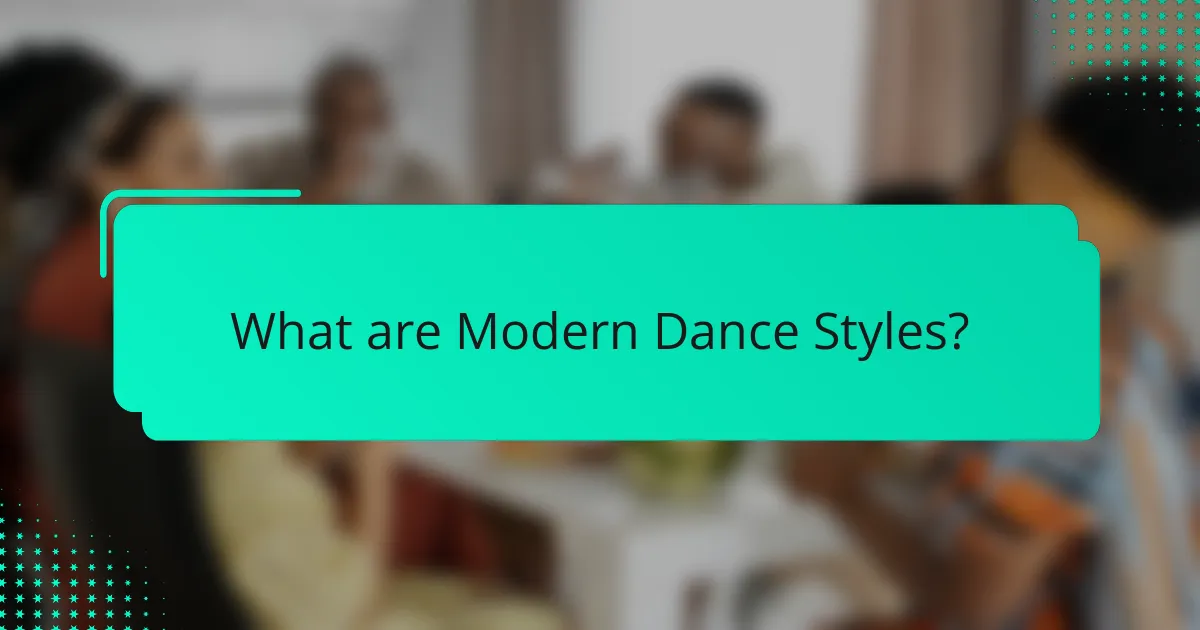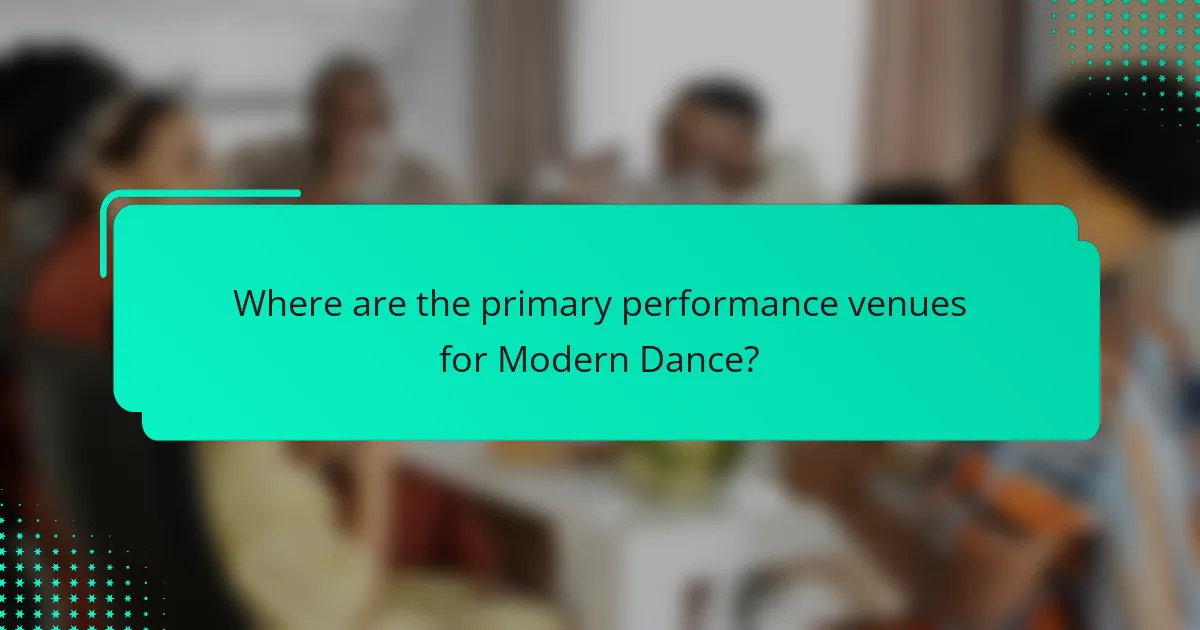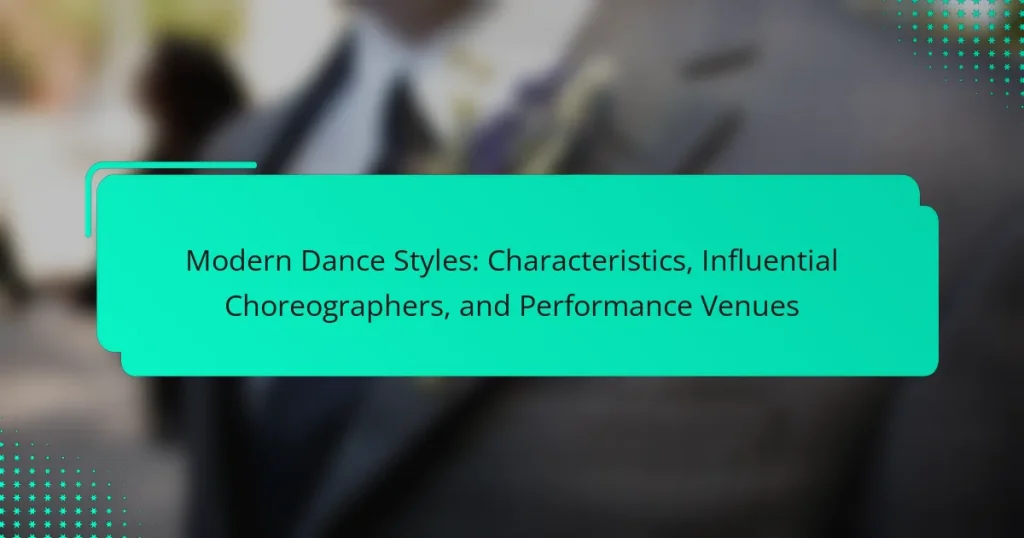Modern dance styles are diverse forms of dance that emerged in the late 19th and early 20th centuries, focusing on expression, creativity, and movement exploration. Unlike classical ballet, these styles emphasize individual interpretation, with techniques that incorporate elements from jazz, ballet, and folk dance. Key modern dance styles include contemporary, lyrical, and improvisational dance, each defined by unique characteristics and movement vocabularies. Influential choreographers such as Martha Graham, Merce Cunningham, and Alvin Ailey have significantly shaped modern dance through their innovative techniques and philosophies. Performance venues for modern dance include theaters, dance studios, and outdoor spaces, which facilitate diverse presentations and community engagement.

What are Modern Dance Styles?
Modern dance styles are diverse forms of dance that emerged in the late 19th and early 20th centuries. These styles prioritize expression, creativity, and the exploration of movement. Unlike classical ballet, modern dance often emphasizes individual interpretation and personal expression. Techniques can vary widely, incorporating elements from various dance forms, including jazz, ballet, and folk dance. Notable modern dance styles include contemporary, lyrical, and improvisational dance. Each style has unique characteristics and techniques that define its movement vocabulary. The evolution of modern dance is marked by influential choreographers like Martha Graham and Merce Cunningham. Their contributions have shaped the landscape of modern dance, making it a vital art form.
How did Modern Dance Styles evolve over time?
Modern dance styles evolved through a series of historical movements and cultural shifts. Initially, modern dance emerged in the late 19th and early 20th centuries as a reaction against classical ballet’s strict conventions. Pioneers like Isadora Duncan and Martha Graham introduced expressive movements that conveyed emotions and personal experiences.
The 1920s and 1930s saw the rise of dance companies and the establishment of modern dance as a formal art form. Influential choreographers developed unique techniques and styles, such as Graham’s contraction and release method. The post-World War II era brought further diversification, with styles like jazz and hip-hop influencing modern dance.
By the late 20th century, modern dance incorporated elements from various cultures and artistic disciplines, reflecting broader societal changes. Today, modern dance continues to evolve, integrating technology and multimedia into performances. This evolution showcases the adaptability and relevance of modern dance in contemporary society.
What historical influences shaped Modern Dance Styles?
Modern dance styles were shaped by various historical influences. The transition from classical ballet to modern dance began in the early 20th century. Pioneers like Isadora Duncan rejected traditional ballet techniques. They sought to express more natural movements and emotions. The influence of social changes, such as women’s rights movements, also played a role. The Harlem Renaissance introduced African American cultural expressions into dance. Additionally, the impact of World War I and II brought new themes of struggle and resilience. Influential choreographers like Martha Graham and Merce Cunningham further defined modern dance’s evolution. Their works emphasized individuality and abstraction, breaking away from classical forms. These historical factors collectively contributed to the diverse landscape of modern dance today.
How have cultural shifts impacted the development of Modern Dance Styles?
Cultural shifts have significantly influenced the development of Modern Dance Styles. The transition from traditional to contemporary values opened avenues for self-expression. Movements such as feminism and civil rights directly shaped dance themes and aesthetics. Choreographers began to explore personal narratives and social issues. The rise of technology also affected performance styles and choreography. Globalization introduced diverse cultural elements into modern dance. This blending of styles created hybrid forms and new techniques. Historical events like wars and social upheavals prompted emotional and thematic explorations in dance. Overall, cultural shifts have led to a more inclusive and varied landscape in Modern Dance.
What are the key characteristics of Modern Dance Styles?
Modern dance styles are characterized by their emphasis on individual expression and creativity. They often break away from traditional ballet techniques. These styles incorporate a wide range of movements and techniques. Dancers may use the floor and their bodies in innovative ways. Improvisation plays a significant role in modern dance. Styles can be influenced by various cultural and social movements. The choreography often reflects personal or societal themes. Notable modern dance styles include Graham, Cunningham, and Horton, each with unique attributes.
What physical techniques define Modern Dance Styles?
Modern dance styles are defined by techniques such as contraction and release, fall and recovery, and improvisation. Contraction and release involve the tightening and loosening of muscles to create expressive movements. Fall and recovery focus on the body’s relationship with gravity, allowing dancers to fall and rise fluidly. Improvisation encourages spontaneous movement, fostering creativity and personal expression. Other techniques include floor work, which emphasizes movement close to the ground, and the use of breath to enhance performance. These techniques reflect the departure from classical ballet, emphasizing individual expression and emotional storytelling.
How do emotional expression and storytelling play a role in Modern Dance Styles?
Emotional expression and storytelling are central to modern dance styles. They allow dancers to convey feelings and narratives through movement. This approach enhances the audience’s connection to the performance. Various choreographers, such as Martha Graham and Alvin Ailey, emphasized these elements in their works. For instance, Graham’s technique focuses on expressing inner emotions through physicality. Ailey’s “Revelations” tells stories of African American culture and experiences. These examples illustrate how modern dance serves as a medium for emotional and narrative exploration. Overall, emotional expression and storytelling enrich the depth of modern dance performances.
What are the different types of Modern Dance Styles?
The different types of modern dance styles include contemporary, lyrical, jazz, and hip-hop. Contemporary dance emphasizes fluidity and improvisation, often blending various techniques. Lyrical dance combines ballet and jazz, focusing on expressing emotions through movement. Jazz dance is characterized by energetic and rhythmic movements, often performed to jazz music. Hip-hop dance encompasses various street dance styles, emphasizing self-expression and individuality. Each style has unique techniques and cultural influences, contributing to the diverse landscape of modern dance.
What distinguishes Contemporary Dance from other Modern Dance Styles?
Contemporary Dance is distinguished from other Modern Dance styles by its emphasis on improvisation and personal expression. This dance form integrates elements from various styles, including ballet, jazz, and hip-hop. Unlike traditional Modern Dance, which often follows specific techniques, Contemporary Dance encourages dancers to explore their own movements. It focuses on the dancer’s body and emotions as tools for storytelling. The fluidity of movement in Contemporary Dance allows for a blend of genres, making it versatile. Additionally, it often addresses contemporary themes and social issues, reflecting current societal contexts. This adaptability and relevance to modern life set Contemporary Dance apart from its counterparts.
How does Jazz Dance integrate elements of Modern Dance?
Jazz Dance integrates elements of Modern Dance through its use of improvisation and expressive movement. Both dance forms prioritize individual expression and creativity. Jazz Dance incorporates the fluidity and body awareness found in Modern Dance. It also employs grounded movements, a hallmark of Modern techniques. The syncopated rhythms of Jazz align with the free-form style of Modern Dance. Choreographers often blend these styles to create dynamic performances. Historical influences, such as the work of Martha Graham, have shaped Jazz Dance. This fusion results in a vibrant and versatile dance style.
What unique features define Hip-Hop as a Modern Dance Style?
Hip-Hop as a modern dance style is defined by its improvisational nature, rhythmic diversity, and strong cultural roots. It incorporates elements from various dance forms, including breaking, locking, and popping. Each of these styles contributes unique movements and techniques. Hip-Hop emphasizes self-expression and individuality, allowing dancers to showcase personal style. The music’s influence is significant, with beats driving the choreography. Additionally, Hip-Hop often includes social and political commentary through dance. This style is performed in various settings, from street corners to professional stages, highlighting its versatility. Furthermore, Hip-Hop culture promotes community and collaboration among dancers, fostering a sense of belonging.

Who are the influential choreographers in Modern Dance?
Martha Graham, Merce Cunningham, and Alvin Ailey are influential choreographers in Modern Dance. Martha Graham is known for her innovative techniques and emotional depth. She founded the Graham technique, which emphasizes the use of contraction and release. Merce Cunningham revolutionized dance with his use of chance procedures and collaboration with other art forms. His work often involved the integration of technology and multimedia. Alvin Ailey is celebrated for his contributions to African American dance. He founded the Alvin Ailey American Dance Theater, which showcases diverse cultural narratives. These choreographers have significantly shaped the evolution of Modern Dance through their unique styles and philosophies.
What contributions did Martha Graham make to Modern Dance?
Martha Graham revolutionized modern dance through her innovative techniques and expressive choreography. She developed a unique movement language based on the principles of contraction and release. This technique emphasized the emotional and psychological aspects of movement. Graham’s works often explored complex themes such as identity, struggle, and the human experience.
Her landmark piece, “Appalachian Spring,” premiered in 1944 and remains a pivotal work in dance history. Graham also founded the Martha Graham Dance Company in 1926, which became a leading institution for modern dance. She influenced countless dancers and choreographers, shaping the evolution of the art form. Graham’s emphasis on personal expression and storytelling set a new standard in performance. Her contributions established modern dance as a respected art form worldwide.
How did Merce Cunningham redefine movement in Modern Dance?
Merce Cunningham redefined movement in Modern Dance by introducing the concept of chance procedures. He emphasized the independence of dance from music, allowing each to exist in its own right. Cunningham’s choreography often involved random selection, leading to unique and unpredictable performances. He utilized non-linear structures, breaking away from traditional narrative forms. This approach encouraged dancers to explore their physicality without preconceived constraints. His collaborations with visual artists and composers further expanded the boundaries of dance. Cunningham’s innovative techniques influenced generations of dancers and choreographers. His work is considered foundational in the evolution of contemporary dance practices.
Which contemporary choreographers are shaping Modern Dance today?
Contemporary choreographers shaping Modern Dance today include Crystal Pite, Kyle Abraham, and Akram Khan. Crystal Pite is known for her innovative choreography that blends movement with narrative. She has received numerous awards for her work, including the Olivier Award. Kyle Abraham incorporates diverse cultural influences and addresses social issues in his performances. His company, Abraham.In.Motion, has gained significant acclaim. Akram Khan merges classical Indian dance with contemporary techniques, creating a unique style. His works often explore themes of identity and migration. These choreographers significantly influence the evolution of Modern Dance through their unique approaches and perspectives.
What innovative techniques are being introduced by current choreographers?
Current choreographers are introducing innovative techniques such as multimedia integration and site-specific performances. Multimedia integration combines dance with video projections and interactive technology. This approach enhances storytelling and engages audiences in new ways. Site-specific performances utilize unique locations to create immersive experiences. These performances often reflect the environment and context of the space. Additionally, choreographers are experimenting with improvisation and collaboration across disciplines. This fosters creativity and allows for diverse artistic expressions. Techniques like body mapping and sensory awareness are also gaining traction. They focus on the dancer’s physicality and personal interpretation of movement. These innovations reflect the evolving landscape of modern dance.
How do these choreographers influence the next generation of dancers?
Choreographers influence the next generation of dancers through innovative techniques and unique styles. They introduce new movements that challenge traditional forms. This exposure encourages dancers to explore creativity and expressiveness. Renowned choreographers often conduct workshops and masterclasses. These sessions provide direct learning experiences for aspiring dancers. Additionally, choreographers share their work through performances and digital platforms. This accessibility allows dancers to study and emulate their techniques. The impact is evident as many dancers cite these choreographers as inspirations. Their work shapes the evolution of dance and cultivates future talent.

Where are the primary performance venues for Modern Dance?
The primary performance venues for Modern Dance include theaters, dance studios, and outdoor spaces. Theaters often host major productions and festivals. Notable examples are the Joyce Theater in New York City and the Sadler’s Wells Theatre in London. Dance studios provide intimate settings for smaller performances and showcases. Outdoor spaces, such as parks and public squares, allow for community engagement and accessibility. These venues support a diverse range of modern dance styles and performances. They play a crucial role in promoting the art form to wider audiences.
What types of venues host Modern Dance performances?
Modern dance performances are hosted in various types of venues. These include theaters, which provide a traditional stage setting with seating for an audience. Dance studios also serve as venues, allowing for intimate performances and workshops. Outdoor spaces, such as parks and festivals, offer unique settings for performances. Additionally, community centers and art galleries can host modern dance events, promoting local artists. Universities often have dedicated performance spaces for student and faculty showcases. Each venue type contributes to the accessibility and diversity of modern dance presentations.
How do theaters differ from alternative performance spaces in showcasing Modern Dance?
Theaters differ from alternative performance spaces in showcasing Modern Dance primarily through their design and technical capabilities. Theaters provide specialized lighting, sound systems, and stage configurations that enhance the visual and auditory experience of a dance performance. This allows for a more polished presentation of choreography.
In contrast, alternative performance spaces, such as warehouses or outdoor venues, often lack these technical features. They may offer a more intimate or raw setting, which can create a unique atmosphere but may not support the same level of production quality.
Theaters typically have a proscenium stage that frames the performance, allowing for a clear focus on the dancers. This contrasts with alternative spaces, which may have a flexible or non-traditional layout that can change the audience’s perspective.
Moreover, theaters often have established audiences and marketing resources, which can lead to higher attendance and visibility for Modern Dance performances. Alternative spaces may attract niche audiences but often face challenges in reaching wider demographics.
In summary, the primary differences lie in technical capabilities, audience reach, and stage design, impacting how Modern Dance is experienced.
What are the most renowned venues for Modern Dance worldwide?
The most renowned venues for Modern Dance worldwide include the Joyce Theater in New York City, the Sadler’s Wells Theatre in London, and the Sydney Opera House in Australia. The Joyce Theater specializes in dance performances and has hosted numerous modern dance companies since its opening in 1982. Sadler’s Wells Theatre is a leading venue for contemporary dance in Europe, showcasing innovative performances from various international artists. The Sydney Opera House is an iconic cultural landmark that hosts a diverse range of modern dance events, attracting global audiences. Other notable venues include the American Dance Festival in Durham, North Carolina, and the Barbican Centre in London, both known for their contributions to the modern dance scene.
What makes the Joyce Theater a significant location for Modern Dance?
The Joyce Theater is significant for Modern Dance due to its dedicated focus on this art form. It provides a platform exclusively for dance performances, showcasing both established and emerging choreographers. The theater has hosted numerous acclaimed companies, enhancing its reputation in the dance community. Its intimate setting allows for close audience engagement with the performers. The Joyce Theater also emphasizes diversity in dance styles, presenting a wide range of cultural expressions. Since its opening in 1982, it has contributed to the growth of Modern Dance in New York City. The venue supports the development of new works through commissioning and residency programs. This commitment to innovation solidifies its status as a vital hub for Modern Dance.
How does the Lincoln Center contribute to the Modern Dance scene?
The Lincoln Center significantly contributes to the Modern Dance scene by providing a premier venue for performances. It hosts renowned dance companies such as the Paul Taylor Dance Company and the Alvin Ailey American Dance Theater. These companies showcase innovative choreography that pushes boundaries within the genre. The center also offers educational programs that promote dance appreciation and training. Workshops and master classes are available for aspiring dancers and choreographers. Additionally, the Lincoln Center’s annual American Dance Festival highlights emerging talent and contemporary works. This fosters a vibrant community for artists and audiences alike. Overall, the Lincoln Center serves as a vital hub for modern dance, supporting both established and emerging artists.
What are some best practices for attending Modern Dance performances?
Arrive early to secure a good seat and acclimate to the venue. This allows time to settle and appreciate the atmosphere. Dress comfortably yet appropriately for the performance. Consider the venue’s dress code, if any, to enhance the experience.
Turn off or silence mobile devices to avoid disruptions. This respects the performers and fellow audience members. Maintain a respectful demeanor during the performance. Applaud at appropriate moments to show appreciation for the dancers’ efforts.
Be mindful of personal space and avoid obstructing the view of others. This ensures everyone enjoys the performance. Familiarize yourself with the program beforehand. Understanding the context can deepen your appreciation of the dance pieces.
Engage with the performance but avoid excessive movement or noise. This helps maintain a focused environment conducive to artistic expression.
How can audiences enhance their experience when watching Modern Dance?
Audiences can enhance their experience when watching Modern Dance by actively engaging with the performance. Understanding the themes and emotions conveyed in the dance can deepen appreciation. Observing the movements and techniques used by dancers provides insight into their artistry. Attending pre-show discussions or workshops can offer valuable context and background. Being open to diverse interpretations of the performance allows for a richer experience. Taking the time to reflect on the performance afterward can solidify understanding and enjoyment. Engaging with fellow audience members about their perspectives can also enhance the overall experience. Research shows that audiences who engage with the art form tend to have a more fulfilling experience (Source: “Audience Engagement in the Arts,” by Smith and Jones).
What should newcomers know before attending a Modern Dance performance?
Newcomers should understand the unique nature of Modern Dance performances. Modern Dance emphasizes expression and often breaks traditional dance rules. Attendees may encounter a variety of styles, from improvisational to structured choreography. It’s common for performances to convey deep emotional themes. The atmosphere can be different from classical dance; expect less formality. Audiences are encouraged to interpret movements personally. Arriving early allows time to absorb the venue’s ambiance. Lastly, being open-minded enhances the overall experience.
Modern Dance Styles encompass a range of expressive dance forms that emerged in the late 19th and early 20th centuries, characterized by individual interpretation and creativity. The article explores the evolution of these styles, highlighting key historical influences and cultural shifts that have shaped their development. It also examines the distinctive characteristics and techniques of various modern dance styles, such as contemporary, lyrical, jazz, and hip-hop, while recognizing the contributions of influential choreographers like Martha Graham and Merce Cunningham. Additionally, the article discusses notable performance venues that showcase modern dance, emphasizing their role in promoting this dynamic art form.




